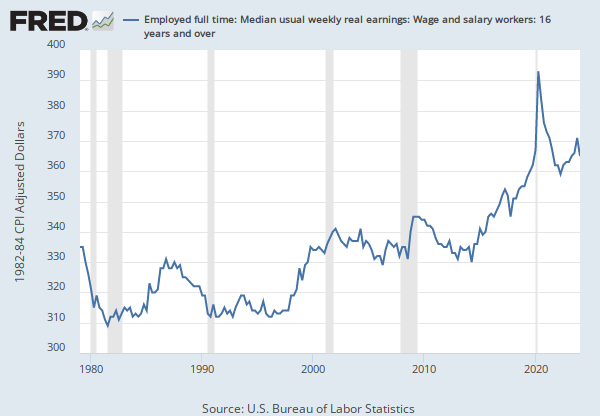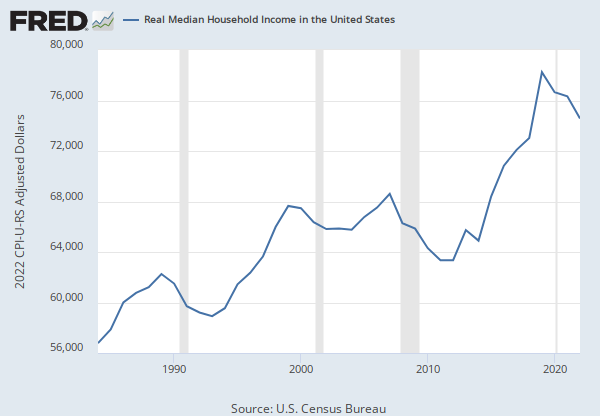FRED Graph
Write a custom formula to transform one or more series or combine two or more series.
You can begin by adding a series to combine with your existing series.
Now create a custom formula to combine or transform the series.
Need help?
For example, invert an exchange rate by using formula 1/a, where “a” refers to the first FRED data series added to this line. Or calculate the spread between 2 interest rates, a and b, by using the formula a - b.
Use the assigned data series variables (a, b, c, etc.) together with operators (+, -, *, /, ^, etc.), parentheses and constants (1, 1.5, 2, etc.) to create your own formula (e.g., 1/a, a-b, (a+b)/2, (a/(a+b+c))*100). As noted above, you may add other data series to this line before entering a formula.
Finally, you can change the units of your new series.
Add the minimum, maximum, and average calculations of selected lines to the graph
Write a custom formula to transform one or more series or combine two or more series.
You can begin by adding a series to combine with your existing series.
Now create a custom formula to combine or transform the series.
Need help?
For example, invert an exchange rate by using formula 1/a, where “a” refers to the first FRED data series added to this line. Or calculate the spread between 2 interest rates, a and b, by using the formula a - b.
Use the assigned data series variables (a, b, c, etc.) together with operators (+, -, *, /, ^, etc.), parentheses and constants (1, 1.5, 2, etc.) to create your own formula (e.g., 1/a, a-b, (a+b)/2, (a/(a+b+c))*100). As noted above, you may add other data series to this line before entering a formula.
Finally, you can change the units of your new series.
Add the minimum, maximum, and average calculations of selected lines to the graph
Data in this graph are copyrighted. Please review the copyright information in the series notes before sharing.
Notes
Source: U.S. Census Bureau
Release: Small Area Income and Poverty Estimates
Units: Percent, Not Seasonally Adjusted
Frequency: Annual
Notes:
The U.S. Census Bureau provides annual estimates of income and poverty statistics for all school districts, counties, and states through the Small Area Income and Poverty Estimates (SAIPE) program. The bureau's main objective with this program is to provide estimates of income and poverty for the administration of federal programs and the allocation of federal funds to local jurisdictions. In addition to these federal programs, state and local programs use the income and poverty estimates for distributing funds and managing programs.
Estimates of poverty by ages and families are not direct counts from enumerations or administrative records, nor direct estimates from sample surveys. Instead, for counties and states, the Census models income and poverty estimates by combining survey data with population estimates and administrative records.
Suggested Citation:
U.S. Census Bureau, Estimated Percent of People of All Ages in Poverty for United States [PPAAUS00000A156NCEN], retrieved from FRED, Federal Reserve Bank of St. Louis; https://fred.stlouisfed.org/series/PPAAUS00000A156NCEN, April 3, 2025.
Source: U.S. Census Bureau
Release: Small Area Income and Poverty Estimates
Units: Percent, Not Seasonally Adjusted
Frequency: Annual
Notes:
The U.S. Census Bureau provides annual estimates of income and poverty statistics for all school districts, counties, and states through the Small Area Income and Poverty Estimates (SAIPE) program. The bureau's main objective with this program is to provide estimates of income and poverty for the administration of federal programs and the allocation of federal funds to local jurisdictions. In addition to these federal programs, state and local programs use the income and poverty estimates for distributing funds and managing programs.
Estimates of poverty by ages and families are not direct counts from enumerations or administrative records, nor direct estimates from sample surveys. Instead, for counties and states, the Census models income and poverty estimates by combining survey data with population estimates and administrative records.
Suggested Citation:
U.S. Census Bureau, Estimated Percent of Related Children Age 5-17 in Families in Poverty for United States [PP5T17US00000A156NCEN], retrieved from FRED, Federal Reserve Bank of St. Louis; https://fred.stlouisfed.org/series/PP5T17US00000A156NCEN, April 3, 2025.
Release Tables
Related Data and Content
Data Suggestions Based On Your Search
Content Suggestions
Related Categories
Releases
Tags
Permalink/Embed
modal open, choose link customization options
Select automatic updates to the data or a static time frame. All data are subject to revision.


















